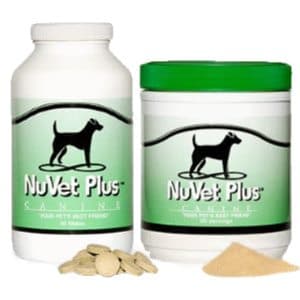Worming Puppies: A Guide for Pet Parents and Breeders
Why, What, When and How
By Janice Jones | Updated 01-08-2024
You might think that worming puppies is simple. Give the pups some worming medicine and all is right with the world. Well, sorry to inform you, it is not as easy as it sounds.
Worming Puppies and Older Dogs
I have been worming puppies for a very long time, mostly as a breeder but also as a puppy parent.
It's not rocket science, but it is important to get it right because internal parasites can wreak havoc in your little baby, whether he's a puppy or a ten year old.
This article is intended to help other breeders as well as puppy parents deal with those pesky parasites and keep your fur friend happy and healthy.
In this article, I will be touching on a number of very important concepts that pertain to worming puppies.
Common and Not So Common Internal Parasites
Types of Parasites
Common and Not so Common Puppy Parasites
Puppies and adult dogs can get parasites both internally and externally. We think of external parasites as fleas, ticks, lice, and mites, those tiny creatures that make their homes on the skin of our furbabies. External parasites are an entirely different ballpark and won't be covered in this article.
Internal parasites, those that reside within our four legged friends is what we will be discussing. Just the though of having something living inside another creature can give even the strongest among us can keep us up at night.
What is a Parasite
Simply put, according to the Center for Disease and Prevention,
“A parasite is an organism that lives on or in a host organism and gets its food from or at the expense of its host.”
There are others, but they are not as common in the northern hemisphere so we will address the most common ones.
Heartworm
Most pet parents are aware of the potential of their pets to acquire heartworm disease. Conscientious parents give their dogs a preventative monthly to protect their dog form the potentially fatal disease.
Heartworm disease is serious and sometimes fatal problem in dogs, cats, and ferrets but can also affect other wild animals including foxes and coyotes.
An adult dog with heartworm disease can have hundreds of adult worms living in their heart, lungs, and the associated large blood vessels around these organs.
Heartworm disease starts when a dog is bitten by an infected mosquito. The baby or larval stage of the heartworm grows to the adult stage within 6 months.
According to the Heartworm Society, an infected dog will show signs such as:
- persistent cough
- reluctance to exercise
- fatigue
- decreased appetite
- eventually, Heart Failure
Luckily, this is a preventable disease. Dogs should be put on a heartworm preventative at the recommendation of their veterinarian. This preventative medication requires a prescription and all dogs over 7 months of age will also need a yearly heartworm test.
The American Heartworm Society recommends that puppies and kittens be started on a heartworm preventive as early as the product label allows, and no later than 8 weeks of age.
Worming Advice to Parents and Breeders
Pet parents should seek the advice of their veterinarian who will normally sell the preventative or write a prescription for you to obtain it often online.
Breeders are faced with making a decision about the puppies they sell. They have the choice of beginning the heartworm preventative and making it a part of their normal worming program, or require the puppy buyers to make a vet appointment shortly after obtaining the puppy.
The biggest problem with preventative in puppies is that they tend to grow fast and the medication is based on the weight of the dog. Again, consult your veterinarian.
Hookworms
According to the Companion Animal Parasite Council (CAPC), the prevalence of hookworms in the U.S. in 2018 is 2.96%. In Canada the rate is 1.57%. That may seem low, but hookworms can wreak havoc with your dog's health and you can also be infected.
Most hookworm infestations occur in warmer climates but no location is immune. This parasite attaches itself to the intestinal wall and sucks the blood of its host. This is particularly problematic in puppies because they can't survive the blood loss.
Adults fair better but still show chronic signs of anemia, diarrhea and weight loss. Eggs are then passed through the GI tract and hatch into a larvae stage which can live in the soil. A dog can come into contact through eating the larvae directly from the soil or licking their skin or through penetration of the skin. The life cycle begins again.
People can get hookworms, but normally by walking barefoot on a beach or on contaminated soil - not directly from their dog.
Roundworms
Roundworms are the most common type of worm found in the dog. It is believed that almost all dogs become infected at some point in their life and often that occurs in puppyhood. They spread easily and are hard to control without worming.
Most puppies are infected with roundworms from the time they are born because the mother passes the worms onto her babies while still in the uterus and then can also be infected through the mother's milk.
Most dogs don't show signs of the worms but some may show the characteristic signs of diarrhea, vomiting, dull hair coat, weight loss and that pot bellied appearance. Puppies can also cough up worms if they pass into the lungs. You can sometimes see the worms if they pass through the dog's feces. They will be a few inches long and resemble spaghetti.
Breeders routinely worm puppies at two week intervals beginning at 2 weeks of age. Nursing moms can be wormed at the same time, but if adults are kept on a monthly heartworm preventative, the medicine will not only control heartworms but also round and hookworms.
Contact with contaminated soil or dog feces can poses a risk to people where children are at the greatest risk. Children should not play in areas soiled with feces. Roundworm infections in people can cause eye, lung, heart and neurological symptoms in people.
Whipworms
What are They, Where do they Live?
There are four major worms found in dogs and whipworms are one of them. These worms occupy the area between the small and large intestines called the cecum. An adult whipworm is about two inches long and tapered at one end making it look like a whip.
How do Dogs get Infected?
The main way that dogs can get infected with whipworms is when they swallow whipworm eggs found in soil, water, or other substances containing dog feces.
What are the Symptoms?
Whipworms are not as big a problem in healthy adults but puppies, seniors, and immune compromised dogs can show symptoms and even death can occur. Symptoms to look for include diarrhea, sometimes bloody, vomiting, weight loss and anemia.
How are They Identified?
Veterinarians can detect the eggs of the whipworm during a routine fecal exam. A fresh sample is necessary.
How to Prevent a Whipworm Infection
The best way to prevent a dog from becoming infected with whipworms is to avoid areas where your dog can come into contact with fecal material.
Tapeworms
What are Tapeworms?
Tapeworms are long flatworms with segmented bodies that can break apart and the pieces can pass in the dog's feces.
How do Dogs Become Infected?
The main way that dogs get tapeworms is by eating an intermediate host that carries the worm. Fleas are a common intermediate host so if dogs have fleas, they can lick or bite at the fleas and thus ingest the larval form of the parasite. They can also get tapeworms from eating the raw meat of other animals.
Dogs that Eat a Raw Diet
According to Dog Naturally Magazine, those folks that feed a raw diet should freeze the meat for 10 days before feeding it to their dog.
A common misconception about tapeworms is that they cause a dog to scoot on the ground. Scooting can be a medical problem but it doesn't have anything to do with tapeworms.
Identification?
Most people will identify the presence of tapeworms in their dog by observing the feces. Each body segment of the tapeworm will look like individual grains of white rice. Other signs to look for include a dull coat decreased appetite and weight loss.
Prevention
The best prevention is flea control. Some heartworm preventatives also kill tapeworm infections.
Coccidia
What are they, and Where do Coccidia Live?
Coccidia are microscopic single celled organisms that live in the wall of your dog's intestine. While more common in puppies, they can also infect older dogs.
How do Dogs become Infected?
They become infected by eating something containing the coccidia such as soil, grass, or contaminated surfaces.
Symptoms?
Coccidiosis is the disease name that is caused by the coccidia parasite and is more serious in young puppies. The main symptom is diarrhea, sometimes bloody diarrhea, dehydration and weight loss Very serious cases can be fatal.
Prevalence?
Surveys indicate that coccidia are present in from 3% to 38% of dogs in North America.
Giardia
 Giardia, Photo Courtesy CDC
Giardia, Photo Courtesy CDCWhat are they and Where do they live?
Like Coccidia, Giardia are one celled parasites that can be seen only with the help of a microscope. They live in the intestines of the dog.
How do Dogs become Infected?
Dogs, especially puppies pick up the giardia organisms by drinking contaminated water or eating the feces or contaminated surfaces such as grass or soil.
What are the Symptoms?
Not all dogs that infected with Giardia show any symptoms, but those that do, especially puppies will have diarrhea watery with mucus), weight loss, poor condition and even death. The severity of symptoms depends on the amount of parasite, stress, nutrition and immune status.
Problems?
The Giardia cysts are passed in the feces and can live for months outside the host in cool, moist conditions but survives for only a short time, in hot, dry weather. It is normally seen during the fall through spring but less common during the summer unless there is standing water that hhas been contaminated.
Giardia is very hard to get rid of and may require more than one round of treatment. It is also easy for your dog's environment to remain contaminated so he gets infected again.
Giardia is also hard to detect with a simple fecal test. Specialized Giardia ELISA tests may be required.
Treating and Worming Puppies
Unfortunately there is not a medicine that will take care of all worms. Before you begin a treatment program is is best to know what worms a puppy may be harboring. This is the main reason why veterinarians ask for a fecal sample when bringing in a new puppy for the first time.
NOTE to BREEDERS
Breeders should plan to worm their puppies beginning at 2 weeks of age and continue until the puppy goes home. Check with your vet for his/her recommendation for worming puppies. There will be differing opinions among veterinarians.
Best Products for Worming Puppies
Excel 8in1 Safe-Guard Canine Dewormer for Dogs, 3-Day Treatment
- Active Ingredient: Fenbendazole
- Treats: Tapeworms, Roundworms, Hookworms, and Whipworms
- Treats Puppies over 6 weeks of age, pregnant dogs and heartworm infected dogs; Fenbendazole is also effective in the treatment of Giardia; Check with your veterinarian for dosage
- Must treat dog for at least 3 days
- Medication Form: Granules in 1 gm pouches that can be mixed in food
- Ideal for an individual dog, but would be too expensive for an entire litter.
Safeguard Goat Wormer 10% Solution
Dog breeders may prefer this product over the one previously mentioned as it is cheaper to worm an entire litter along with the dam. Used in multi-dog households, rescues and shelters
- Active Ingredient: Fenbendazole
- Treats: Roundworms, Hookworms, Whipworms, Tapeworms, Giardia
- Dosage: 1 ml per 5 pounds; Must be used for 3 consecutive days for worms and 5 days to treat Giardia. Do not miss a day
- Safe in pregnant and lactating females
- Not recommended for puppies under six weeks of age
- Check price for Safeguard Dog Wormer on Amazon
Nemex-2
- Active Ingredient: Pyrantel pamoate
- Each mL contains 4.54 mg of pyrantel base as pyrantel pamoate.
- Treats: Hookworms and Roundworms
- Treat puppies at 2, 4, 6, 8 and 10 weeks of age
- Not for pregnant moms but can be used on nursing dams.
- Medicine Form: Liquid
- Has a favorable taste to puppies (caramel flavor)
- Does not require a prescription
- Dosage: 5 ml for a 10 pound dog
- Comes in 2 sizes: 2 ounces and 16 ounces
- Does not require a prescription
- Check prices for Nemex-2 on Amazon
Pyrantel Pamoate Suspension 50 mg 32 oz bottle
Many breeders prefer this medicine over the Nemex-2 because it is more economical. Note, the dosage for this medicine is NOT the same as the Nemex-2
- Active Ingredient: Pyrantel pamoate 50mg/ml
- Dosage 2.5 ml per 25 pounds
- Treats: Hookworms and Roundworms
- Treat puppies at 2, 4, 6, 8 and 10 weeks of age
- Not for pregnant moms but can be used on nursing dams.
- Medicine Form: Liquid, vanilla flavored and palatable to puppies
- Does not require a prescription
- Check Prices for Pyrantel Pamoate Suspension on Amazon
Bayer Tapeworm Dewormer for Dogs
- Active Ingredient: praziquantel
- Treats: Tapeworms
- Medication Form: Tablet Can be crumbled over food
- Safe for: Dogs over 4 weeks
- This is a good all round wormer for dogs with tapeworms.
- If you treat your dog for fleas, Bayer recommends also checking for tapeworms and treating as needed. Fleas should be treated at the same time as worming for tapeworms.Dogs that chase or eat rodents are also at high risk for tapeworms. Worming on a monthly basis may be necessary for dogs that are at high risk for fleas or hunting.
- Check prices for Tapeworm dewormer on Amazon
Albon
Albon (sulfadimethoxine) is the only FDA approved drug, for treating Coccidia. It is a prescription antibiotic drug. It is used for the treatment of certain bacterial infections as well as treatment of coccidiosis, and the most commonly prescribed medication for Coccidia in the U.S.
It comes in both pill and liquid form. There is no generic form as of this writing and will require the prescription from a licensed veterinarian. This medication does not kill coccidia but prevents it from reproducing.
Toltrazuril
Toltrazuril (Baycox) – This is labeled for treating coccidia for poultry. Used as an alternative treatment for coccidiosis in dogs and cats, and the oocyte shedding stage of toxoplasmosis in cats. Not commercially available in the US, but can be imported and does not require a prescription.
Metronidazole (Flagyl)
Metronidazole (Flagyl) – This drug is an antibiotic that is also used to treat infections such as Giardia, in dogs. It is a prescription medication but can be obtained over-the-counter as Fish Zole (a medication sold as a fish antibiotic).
Additional References and Resources
https://www.cdc.gov/parasites/giardia/
https://www.merckmanuals.com/home/SearchResults?query=dog+parasites
Additional Consideration
Hygiene is important to prevent re-infetion. Several methods are required:
1. Clip hair around the hind end
2. Whip with baby wipes after defecation
3. Routine bathing
4. Pick up stools immediately
5. Steam clean hard surfaces
6. Quaternary ammonium disinfectants
About Janice
Janice is the voice behind Miracle Shih Tzu. Having lived with dogs and cats most of her life, she served as a veterinary technician for ten years in Maryland and twelve years as a Shih Tzu dog breeder in Ohio.
Her education includes undergraduate degrees in Psychology with a minor in biology, Early Childhood Education, and Nursing, and a master's in Mental Health Counseling.
She is a lifelong learner, a dog lover, and passionate about the welfare of animals. Her favorite breed for over 50 years has been the Shih Tzu.
When not writing, reading, or researching dog-related topics, she likes to spend time with her eight Shih Tzu dogs, her husband, and her family, as well as knitting and crocheting. She is also the voice behind Small Dog Place and smart knit crocheting.



